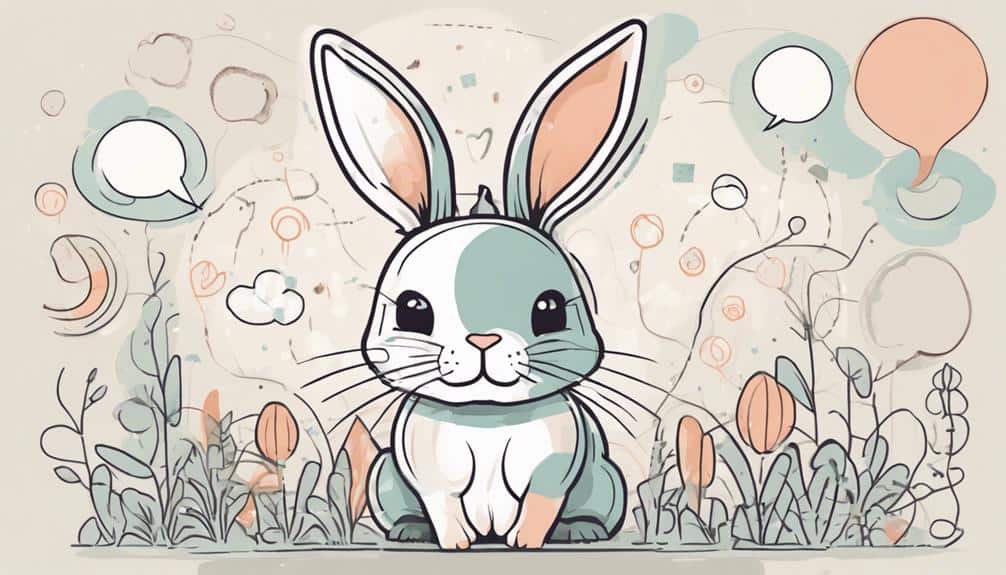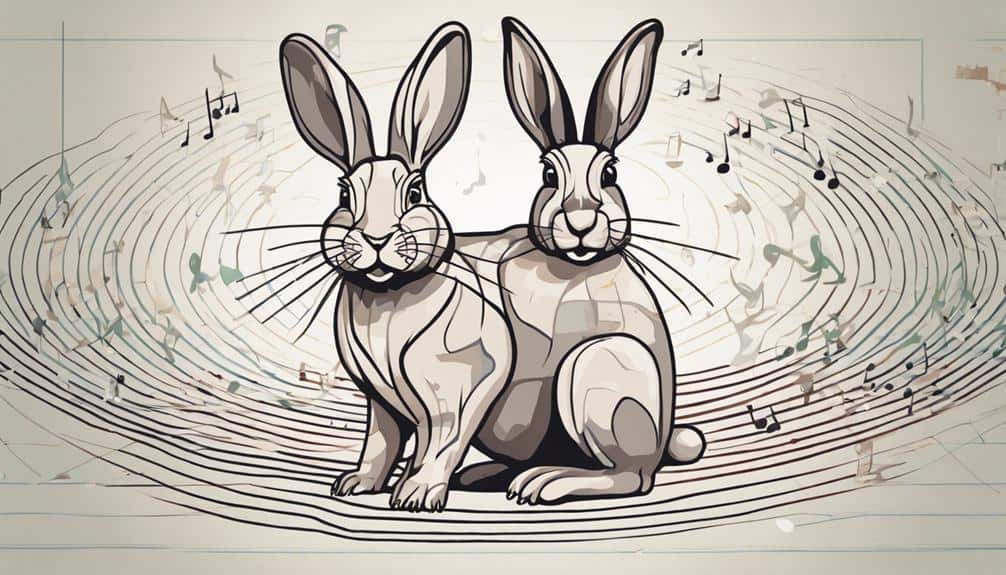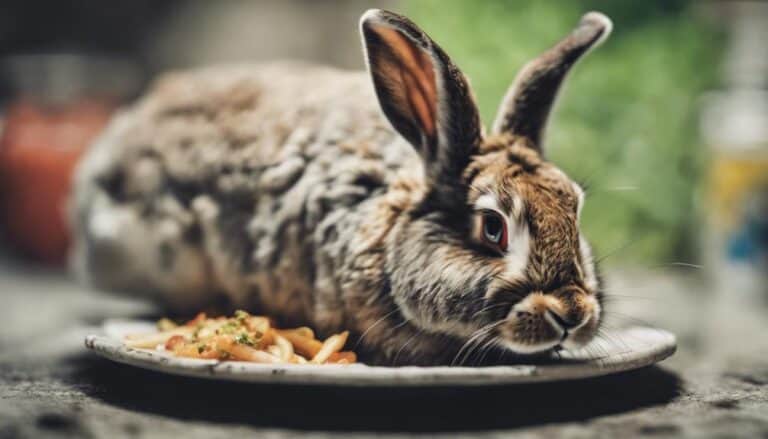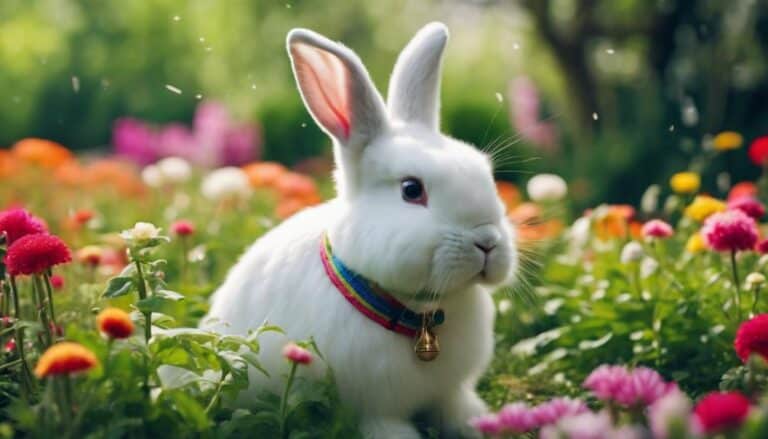Imagine a serene garden at dusk, where the only sound is the gentle rustling of leaves in the breeze.
In such peaceful surroundings, have you ever wondered if bunnies break this tranquility with their own unique sounds?
While these small creatures may seem quiet at first glance, there's more to their vocalizations than meets the ear.
Exploring the domain of bunny noises reveals a fascinating world of communication that might surprise you.
Contents
- 1 Key Takeaways
- 2 Common Bunny Sounds Explained
- 3 Happy Bunny Noises Decoded
- 4 Unhappy Bunny Noises Decoded
- 5 Understanding Rabbit Communication
- 6 Deciphering Rabbit Vocalizations
- 7 Bunny Sounds and Their Meanings
- 8 Interpreting Rabbit Noises
- 9 The Language of Bunnies
- 10 Can Bunny Purring Be Considered as a Form of Noise?
- 11 Frequently Asked Questions
- 12 Conclusion
Key Takeaways
- Bunnies make various noises to communicate emotions and needs.
- Understanding bunny vocalizations helps interpret their well-being and feelings.
- Body language complements bunny sounds for a complete communication understanding.
- Promptly addressing distress signals is crucial for ensuring bunny welfare.
Common Bunny Sounds Explained

When deciphering the meaning behind common bunny sounds, it's essential to understand the various vocal cues these animals use to communicate their emotions and needs effectively. Rabbits make a range of sounds, from clucking and honking to purring and growling, each carrying a distinct message.
Clucking typically indicates contentment, while honking suggests excitement or anticipation. The gentle purring of a rabbit often signifies calmness and contentment. On the other hand, growling serves as a warning sign of anger, indicating that the bunny feels threatened or irritated.
In addition to vocalizations, rabbits also use body language to express themselves. For instance, teeth grinding can indicate pain or discomfort, and thumping is a loud non-vocal sound used as a warning when bunnies feel scared or annoyed. By paying attention to these sounds and behaviors, you can better understand and cater to your rabbit's emotional needs.
Happy Bunny Noises Decoded
Happy Bunny Noises can be decoded to understand your rabbit's emotions and needs effectively.
- Clucking: When your bunny makes clucking noises, it indicates satisfaction with its food. This content sound lets you know that your rabbit is enjoying its mealtime.
- Purring: Just like cats, happy bunnies purr to express contentment and joy. This gentle sound signifies that your rabbit is relaxed and happy in its environment.
- Binkying: Binkying is a joyful sound that shows excitement and happiness in rabbits. When your bunny is binkying, it means they're feeling playful and exuberant, hopping around in delight.
Unhappy Bunny Noises Decoded

Decode unhappy bunny noises to understand your rabbit's emotions and needs effectively. Unhappy bunnies may exhibit various sounds that can provide insights into their well-being.
Growling, snorting, and hissing are signs of aggression or feeling threatened. Whining or whimpering typically indicate discomfort, fear, or protest. Foot stomping or thumping often signifies fear or nervousness in your bunny.
However, if you hear teeth grinding, it's a red flag for severe pain, requiring immediate medical attention. In cases of extreme fear or pain, bunnies may scream, indicating a need for urgent help.
Understanding these various unhappy bunny noises will help you respond promptly to your rabbit's distress signals. By being attentive to these sounds and the corresponding emotions they convey, you can safeguard the well-being and happiness of your furry companion.
Understanding Rabbit Communication
Understanding Rabbit Communication involves interpreting a range of vocalizations and body language cues to grasp their emotions and needs effectively. When interacting with rabbits, pay attention to the following:
- Vocalizations: Rabbits communicate through various sounds like clucking, honking, purring, growling, and screaming. Each sound conveys different emotions such as contentment, excitement, aggression, distress, and pain.
- Body Language: Observing a rabbit's body language is important in understanding their vocalizations accurately. Different postures, ear positions, and movements provide valuable insights into their feelings and intentions.
- Signs of Pain: Sudden loud squealing, teeth grinding, or wheezing are indicators of distress or pain in rabbits. Promptly addressing these signs is important to make sure the well-being of your rabbit.
Deciphering Rabbit Vocalizations

When deciphering rabbit vocalizations, keen observation and understanding of their various sounds are essential for accurately interpreting their emotions and needs. Rabbits communicate through a range of noises, each carrying a distinct meaning. Below is a table to help you interpret rabbit noises effectively:
| Noise | Meaning |
|---|---|
| Clucking | Indicates contentment |
| Honking | Can signify excitement or warning |
| Purring | Reflects happiness and comfort |
| Growling | Signifies anger or threat |
| Screaming | Indicates extreme distress |
These vocalizations are critical for you to comprehend as they provide insights into your rabbit's emotional state. By paying attention to these sounds, you can better understand how your bunny is feeling and what they might require. Interpreting rabbit noises will strengthen your bond with your furry companion and guarantee their well-being.
Bunny Sounds and Their Meanings
When it comes to understanding bunny sounds, recognizing the various vocalizations your bunny makes is crucial. Clucking, purring, honking, and teeth grinding are all unique sounds that convey different meanings.
Bunny Communication Sounds
Bunny communication sounds, known as bunny sounds, convey various emotions and messages through different vocalizations. Here are some key sounds and their meanings in rabbits:
- Clucking: Indicates contentment, showing satisfaction with food or the current situation.
- Growling: Signifies anger, feeling threatened, or disapproval in rabbits.
- Honking: Can suggest mating behavior, excitement, or seeking attention in bunnies.
Understanding these sounds can help you interpret your bunny's feelings and needs accurately. Remember, each sound is a form of communication that your bunny uses to express itself.
Understanding Bunny Vocalizations
Understanding the nuances of bunny vocalizations can provide valuable insights into your rabbit's emotional state and needs. Bunnies communicate through a variety of sounds like clucking, honking, purring, growling, and thumping.
When your bunny clucks, it indicates contentment, while honking shows excitement, and purring signifies happiness. On the other hand, growling signals aggression, and thumping indicates fear. By paying attention to these sounds, you can better interpret your rabbit's emotions and respond accordingly.
Effective communication through understanding bunny vocalizations is essential for caring for rabbits and ensuring their well-being. As a responsible rabbit owner, being attuned to these sounds will help you communicate effectively with your furry companion and provide the best possible care.
Interpreting Rabbit Noises

To interpret rabbit noises effectively, pay close attention to the various sounds they make and the corresponding emotions they convey. Understanding these vocalizations can provide valuable insights into your rabbit's well-being and help you respond appropriately to their needs.
Here are three key points to bear in mind when interpreting rabbit noises:
- Range of Sounds: Rabbits communicate through a variety of noises such as clucking, honking, purring, growling, and screaming. Each sound signifies a different emotion or message, allowing you to grasp what your rabbit is trying to convey.
- Emotional Cues: Different sounds indicate a range of emotions in rabbits, including contentment, distress, pain, or aggression. By listening carefully and observing your rabbit's body language, you can better interpret their emotional state and respond accordingly.
- Immediate Action: Distress signals like screaming or continuous teeth grinding require immediate attention. Responding promptly to these vocal cues can help address any issues or discomfort your rabbit may be experiencing, enhancing your communication and bond with them.
The Language of Bunnies
Bunnies use a variety of sounds to communicate, such as clucking, honking, and purring. Each sound carries a different message, ranging from happiness to distress.
Bunny Communication Signals
When listening to bunnies communicate, you can discern a range of emotions through their diverse sounds like clucking, purring, honking, and teeth grinding. Understanding bunny vocalizations is key to interpreting their needs and feelings. Here's how you can decode their communication signals:
- Different Sounds, Different Emotions: Each bunny noise conveys a specific emotion, from happiness to distress.
- Observing Context is Essential: Pay attention to the situation in which the sound is made to understand its meaning.
- Body Language Matters: Combine vocalizations with body cues like nudging or circling for a complete picture of what your bunny is trying to communicate.
Understanding Bunny Behavior
Understanding the behavior of rabbits entails decoding their unique communication signals to establish a deeper connection with these small animals. When it comes to Sounds That Rabbits Make, you need to listen carefully as each sound conveys a different message about what the rabbit feels. For instance, a rabbit makes tooth purring sounds when content, but if you hear growling, it might indicate a warning sign. In cases where a rabbit is in a lot of pain, they might make distressing noises like loud honking or high-pitched squealing. Being attuned to these vocalizations helps caretakers respond appropriately to the emotional needs of their bunnies, fostering a stronger bond and ensuring their well-being.
| Sound | Meaning | Example |
|---|---|---|
| Tooth Purring | Contentment | After being petted |
| Growling | Warning sign | Approached by a predator |
| Honking | Distress or pain | Injured leg |
Non-Verbal Bunny Cues
Deciphering the non-verbal cues of rabbits provides invaluable insights into their emotions and intentions, fostering a deeper understanding of their behavior. When interacting with bunnies, paying attention to their body language is essential.
Here are some key non-verbal cues to look out for:
- Thumping: Rabbits thump their hind legs to express fear, annoyance, or to alert others of potential danger.
- Circling: Circling behavior can indicate that a bunny is exploring, feeling playful, or trying to establish dominance.
- Bonding: Grooming, nudging, and chinning are signs of affection and bonding among rabbits.
Understanding these cues can help strengthen the bond between you and your bunny, ensuring a happy and healthy relationship.
Can Bunny Purring Be Considered as a Form of Noise?
Bunnies purring behavior is often considered a form of noise, although it is generally much quieter and more soothing than traditional forms of noise. Many bunny owners find the sound of their bunnies purring to be quite calming and enjoyable, rather than disruptive or bothersome.
Frequently Asked Questions
What Noise Does a Bunny Make?
Bunnies communicate through various vocalization patterns, conveying their emotions and needs effectively. Understanding rabbit language involves recognizing sound signals like clucking, honking, purring, growling, and thumping, which reflect their noise behavior and feelings accurately.
Do Bunnies Make Noise When Happy?
When happy, bunnies make playful sounds, exhibit joyful behaviors like the happy dance and binkying, and communicate contentment through quiet companionship. Understanding rabbit communication helps you bond with your bunny and secure their well-being.
Why Do Bunnies Squeak?
When bunnies squeak, it's their way of communicating. Squeaking behavior in rabbits reveals distress or discomfort. Understanding bunny language is pivotal for their well-being. Noisy rabbits may need immediate attention for their health and happiness.
Do Rabbits Make Noise at Night?
At night, rabbits may exhibit various behaviors due to their nocturnal activities and sleep patterns. Factors like stress or discomfort can lead to occasional noises. Monitoring your rabbit's environment is essential to understand and address any disturbances.
Conclusion
In summary, understanding your bunny's noises is important for building a strong bond with your furry friend.
For example, imagine coming home to hear your rabbit softly purring and honking with delight at your presence, showing you how much they love and appreciate you.
By listening and interpreting their vocalizations, you can better communicate with your bunny and guarantee their happiness and well-being.
So, pay attention to those adorable bunny sounds and cherish the special connection you share with your beloved pet.






